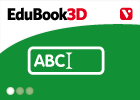Cargando...
Recursos educativos
-
Nivel educativo
-
Competencias
-
Tipología
-
Idioma
-
Tipo de medio
-
Tipo de actividad
-
Destinatarios
-
Tipo de audiencia
-
Creador
Lo más buscado
- Actividades artísticas para niños
- Historia de Papá Noel
- Repaso y material didáctico adicional
- Alimentación saludable
- Actividad de multiplicaciones
- Cómic para rellenar
- Estadística descriptiva
- Plantillas de letras
- Experimentos de botánica
- Repaso de fisica
- Higiene bucal
- Términos geográficos
- Alteración del lenguaje
- Letras X
- Competencias básicas
-

Avaluació final - Els primers pobladors
EduBook Organización
- 2277 visitas
La Prehistòria és el primer gran període de la humanitat i va durar milions d'anys. Aquest període comença amb l'aparició dels primers éssers humans damunt la Terra i s'acaba amb la…
-

Per saber-ne més
EduBook Organización
- 2278 visitas
Quan comencen la vida, la majoria dels insectes són molt diferents del seu estat adult, i aleshores reben el nom de larva. Moltes larves són anomenades erròniament "cucs", perquè tenen forma…
-

Interpreta. Líquid amniòtic
EduBook Organización
- 2277 visitas
Per tal que es trobi més ben protegit a dins de l'úter, l'embrió (o fetus) està envoltat d'una bossa que conté un líquid anomenat líquid amniòtic: Identifica a la fotografia el…
-

Contesta. Substàncies pures i mescles
EduBook Organización
- 2279 visitas
Recorda el que has treballat en aquest apartat i contesta: Indica si les substàncies següents formen mescles homogènies amb l'aigua: oli, sucre, sorra i sal. Explica com pots aconseguir separar…
-

Answer. Monasteries
EduBook Organización
- 2282 visitas
Remember what you have studied in this section and answer the questions: Who lived in monasteries? And in convents? What was the head of the monastery called? What were the rules in monasteries like?…
-

Summaries - Plants
EduBook Organización
- 2274 visitas
1. Plants and their classification Plants make their own food. They contain a green pigment called chlorophyll. They cannot move from place to place. Plants are classified into non-flowering plants…
-

Answer. Plants
EduBook Organización
- 2276 visitas
Look at the photos: Describe the plants you can see. Can you name any of them? What differences and similarities can you see between the plants? How are plants different to animals? Why are plants so…
-

Initial evaluation 03 - Animal reproduction
EduBook Organización
- 2283 visitas
Choose the correct answer in each case: The type of reproduction which only requires one individual: The male reproductive system makes... Animals that hatch from eggs are called... Which of these…
-

Different types of fruit
EduBook Organización
- 2278 visitas
Fruits have many different forms. We can classify fruits into two principal groups: Fleshy or dry. Write the names of the fruits in the pictures and indicate whether they are fleshy or dry. Do fruits…
-

Complete. Energy and forces
EduBook Organización
- 2281 visitas
Copy and complete the following sentences in your notebook: change deformation state distance deformations changes forces Kinetic energy acts on objects using . Forces produce movements and . Heat…
Te estamos redirigiendo a la ficha del libro...













